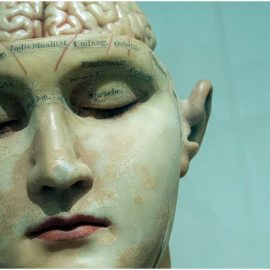

This article is an excerpt from the Shortform book guide to "The Boy Who Was Raised as a Dog" by Bruce D. Perry and Maia Szalavitz. Shortform has the world's best summaries and analyses of books you should be reading.
Like this article? Sign up for a free trial here.
What does the dissociation trauma response look like? What is the cause of it?
The dissociative trauma response involves the traumatized person withdrawing into their own mind, creating distance between themselves and reality. If you can understand why this happens and what triggers are causing recurrences, you’ll be more equipped to help someone going through this.
Learn what the dissociation trauma response is and why it happens.
Dissociation as a Stress Response
In many of the cases in which children’s stress response systems become overactive due to excessive stimulation, physiological checks on the children showed that their heart rates were elevated, a sign of the fight or flight response. However, the body has other ways to respond to stress depending on the situation. In cases where a threat is too great to escape or fight off, the brain may activate a dissociation trauma response—a response particularly common in children, who often lack the physical or mental means to fight or flee from a threat.
Dissociation prepares the body to endure physical harm: It slows breathing and reduces blood flow and heart rate, which can help the body avoid bleeding to death, and the brain releases natural opioids that can alleviate pain and help the person detach psychologically from what’s happening to them.
Both hyperarousal and dissociative responses occur on a spectrum: Hyperarousal may look like a slightly elevated heart rate and nervousness or full-blown panic. Dissociation may take the form of daydreaming, or in extreme cases may cause the person to completely detach from reality and withdraw into their own mind. They become calm and numb, time seems to slow, and it feels as if what’s happening to them isn’t real and like they’re watching it happen to someone else. Additionally, these responses rarely occur in complete isolation: Most trauma responses involve a combination of hyperarousal and dissociation.
| Dissociative Disorders: How Dissociation Manifests When It Occurs Too Often As with the hyperarousal response, activating the dissociative response too frequently can result in a disorder in which the response is activated even in the absence of a real threat. These are known as dissociative disorders. The DSM-5 recognizes three major types of dissociative disorders: depersonalization/derealization disorder, dissociative amnesia, and dissociative identity disorder. Depersonalization-derealization disorder is characterized by feelings of detachment and numbness. With depersonalization, the person feels detached from their identity and their own existence, like they’re watching themself from a distance. With derealization, the person feels detached from reality itself. A person may experience just one of these types of dissociation or both. Dissociative amnesia occurs when the dissociative response results in significant memory loss, such as being unable to remember a certain period of time (like a traumatic incident) or being unable to remember details about one’s life. Dissociative identity disorder (previously known as multiple personality disorder) occurs when a person has multiple identities. In such cases, the identities are referred to as alternate identities, or just alters, and a collection of alters is known as a multiple system. As with the other dissociative disorders, this tends to result from severe childhood trauma. When a situation is too overwhelming, an alter may appear or take control of the body to keep the person safe from what’s happening to them. Experiencing dissociation doesn’t necessarily mean you have a dissociative disorder, and dissociation can be a symptom of other disorders or a side effect of some medications. Dissociative experiences can also co-occur with hyperarousal-type experiences such as panic attacks. Lastly, though dissociation and psychosis share some characteristics, they’re not the same thing. While they can both involve a sense of detachment from the world and may result from trauma—and a psychotic episode may be preceded by dissociation—psychosis usually involves delusions and hallucinations, which are not typically characteristics of dissociation. |
A Natural Opioid Overdose: Amber’s Case
To illustrate the danger of dissociation, we will look at the case of Amber, a teenage girl who was hospitalized after being found unconscious in the bathroom at her school. She remained comatose for several hours, and at one point her heart stopped and she had to be resuscitated. Tests showed no medical reason for her loss of consciousness, but in talking with Amber’s mother, her psychiatrist discovered that Amber had been sexually abused by one of her mother’s boyfriends over the course of two years, starting when she was seven.
The psychiatrist learned from Amber that during these instances of abuse, she dissociated in order to endure the trauma, retreating to a safe place in her mind. This safe place was so immersive that it kept her from feeling the physical sensations of what was happening to her body. Because of the associations she developed as a result of this, any reminder of that boyfriend could induce an involuntary dissociation, even long after the abuse ended.
(Shortform note: Amber’s experience doesn’t seem reflective of any of the three major dissociative disorders but might be described as a specified dissociative disorder—which refers to a dissociative disorder that doesn’t fit into any of the three major diagnoses described above. As with many coping mechanisms, Amber’s safe place was useful for her survival at the time but became problematic later. However, some people use a “safe place” for reasons unrelated to trauma: Some people like to consciously establish a safe place in their mind to help them relax or for meditative purposes. This can be a useful tool, but it’s different from the immersion of dissociation.)
The night before her hospitalization, Amber had answered a call from her mom’s abusive boyfriend, and he mentioned that he might come visit them. Her psychiatrist theorized that this call had activated a serious threat response in Amber because her experiences had sensitized her to any stressors related to that boyfriend. Her brain released so many natural opioids to cope with the expected harm that she essentially overdosed on them. His suspicions were confirmed when they brought her back to consciousness by administering an anti-overdose drug.
(Shortform note: A sudden onset of mental illness symptoms is often preceded by an unexpected trigger like the call that Amber answered. Because of this, some experts suggest that asking a patient what was happening just before their symptoms were triggered is one of the most important things a therapist can do. This can help a patient get to the root cause of their issue rather than just treating the symptoms.)

———End of Preview———
Like what you just read? Read the rest of the world's best book summary and analysis of Bruce D. Perry and Maia Szalavitz's "The Boy Who Was Raised as a Dog" at Shortform.
Here's what you'll find in our full The Boy Who Was Raised as a Dog summary:
- How trauma impacts the developing brains of children
- Case studies of child abuse and neglect, as told by a child psychiatrist
- An explanation of the Neurosequential Model of Therapeutics






